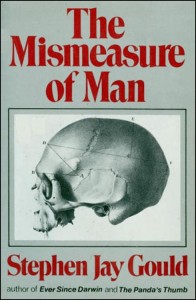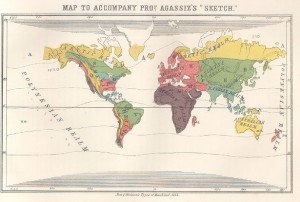Lesson Objectives:
- describe scientific racism
- explain the role of anthropology and the social construction of race
- recognize the role of ‘social hygiene’ and the eugenics movement in human rights violations and the holocaust
- formulate a position on the role of contemporary anthropology and research on and about race
The previous section addressed the concept of ‘race’ as a social construct which is an invented idea that emerges from a particular social system and is assumed to be true by those who accept it. This section will address ‘race science’ and explore the role of early anthropologists in creating racial categories as well as the social implications of ‘scientific racism’.
Scientific racism is the use of scientific techniques to categorize and classify ‘races.’ Naturalists, biologists and social scientists employ methodologies such as anthropometry and craniometry and other techniques aiming to measure biological data in order to construct typologies of discrete human groups. In most cases, race typologies were based on evolutionary models and ecological ‘laws’ and ‘principles’ to explain human development and difference.
Some of the earliest race models emerged from the work of naturalists such as George Cuvier who constructed three human race groups, James Cowles Pritchard who constructed seven human race groups, Louis Agassiz who constructed twelve human race groups and Charles Pickering who introduced eleven human race groups in his book Races of Man and Their Geographical Distribution (1848). In most cases, race typologies were organized hierarchically in publications such as Indigenous Races of the Earth (1857), where Josiah Clark Nott and George Robins Gliddon implied that “Negroes” were ranked between “Greeks” and chimpanzees.
One of the earliest debates among evolutionary biologists and anthropologists centered around the origin of human races. Polygenists such as Agassiz, Cuvier and Gliddon hypothesized that each human race originated in a different geographic location. Monogenists such as Charles Pickering and Charles Darwin argued that humans emerged from a single common origin. Both camps included those who relied on biblical interpretations as well scholars who employed scientific approaches. Biblical monogenists referred to the creation story in the book of Genesis to argue that humans descended from ‘Adam’ and ‘Eve’. Biblical polygenists developed a theory called coAdamism which argues that there was more than one Adam and/or the authors of the biblical texts were simply unaware of the existence of other human groups.
In the scientific arena, the empirical approach to mongenism revolved around Charles Pickering’s work Researches into the Physical History of Man (1813). In response, several polygenist scholars collaborated to produce a 738 page ethnography entitled Types of Mankind (1854) and was later followed by Indigenous Races of the Earth (1857). Charles Darwin’s publication, Origin of Species (1859), retaliated with a convincing evolutionary argument for common descent that eventually won over many polygenists. Contemporary technology in the 21st century has identified mitochondrial evidence that firms that modern humans emerged from a single ancestor in Africa, known as Mitochondrial Eve, approximately 200,000 years ago and migrated out of Africa approximately 55,000 years ago. For more information about Mitochondrial Eve, watch the documentary The Real Eve by the Discovery Channel.
Today, genetic evidence confirms the monogenic perspective that modern humans share a common ancestor. Despite compelling evidence, many polygenists continue to hold on to the idea that human races emerged from multiple ancestors, and contemporary race models such as the multiregional hypothesis (Wolpoff 1985) continue to promote the polygenist perspective well into the 21st century.
Why was race so important?
Contemporary critical race theorists point out the political and economic motivations behind race science, human origin debates and the construction of hierarchical human typologies. Race science emerged from the activities of colonial imperialists who aimed to document and describe indigenous people and situate non-European cultures into a globalized interpretation of social organization. Race science also helped reconcile tensions between contradictory practices on the part of Europeans and euro-centric settler nations such as the United States. While European imperialists occupied foreign territories and engaged in the enslavement and exploitation of indigenous people, revolutionary ideas about ‘liberty’ and ‘equality’ were leading to the proliferation of democractic institutions throughout Europe and post-colonies such as the United States. Europeans and Americans were faced with the the hypocritical contradictions associated with ideas revolving liberty and equality while engaging in exploitative institutions such as enslavement and occupation. Race science helped justify inequality and exploitation by positioning exploited people as ‘inferior’, and establishing the framework for moral justifications associated with ‘The White Man’s Burden’ and social and evolutionary development.
Many scientists produced scientific findings to legitimize atrocities and human exploitation committed by imperialists and slave-owners. For example, an American Physician named Samuel Cartwright published Diseases and Peculiarities of the Negro Race (1851) where he described a mental condition called drapetomania that allegedly compelled enslaved people to to run away from their owner. He claimed that the condition was induced by masters who became too familiar with or too kind to enslaved people, and his recommended treatment was based on whipping and removing the big toes to impede the ability to run. Cartwright’s research was accepted and distributed by the Medical Association of Louisiana.
Physical scientists also aimed to prove the racial inferiority of non-European people by producing comparative evidence of measurable biological data. In his book, Crania Americana; or, A Comparative View of the Skulls of Various Aboriginal Nations of North and South America: To which is Prefixed An Essay on the Varieties of the Human Species (1839), Samuel George Morton measured the cranial capacity (brain size) of skulls representing different groups (e.g. “Blacks,” “American Indians,” “Whites”); and concluded that some “races” were superior to others. Based on the assumption that brain capacity determines intelligence, he concluded that the ‘white’ race was superior because ‘white’ skulls were the largest, followed by ‘Asian’ skulls, which were followed by ‘American Indian’ skulls, and ‘black’ skulls were positioned at the bottom. Morton’s research was widely recognized and distributed throughout academic institutions, particularly in the southern United States. Morton was considered a distinguished professor of human anatomy and his scientific methodologies remained unquestioned for more than 100 years.
 In 1981, Stephen Jay Gould published The Mismeasure of Man which revealed that like many race scientists of that time, Samuel George Morton produced research that supported a pre-existing agenda. Gould remeasured the skulls used in Morton’s sample to identify bias in the research study. According to Gould, Morton’s findings were influenced by his sample selection. Female skulls are generally smaller than male skulls; Morton included more female skulls in the ‘black’ sample and more male skulls in the ‘white’ sample. Within the ‘American Indian’ sample, Morton included smaller Inca skulls rather than the larger skulls of Iroquois. In fact, Gould found that the average size of the ‘black’ male skulls was larger than the average size of the ‘white’ male skulls. Despite patterns in the measurements however, there is no scientific evidence to support the relationship between brain size and intelligence. Gould’s research shed light on the ways that scientific ‘truths’ are shaped by the nature of the question, the selection of the sample, the ways that the data is analyzed, and the ways that conclusions are affected by interpretation and bias.
In 1981, Stephen Jay Gould published The Mismeasure of Man which revealed that like many race scientists of that time, Samuel George Morton produced research that supported a pre-existing agenda. Gould remeasured the skulls used in Morton’s sample to identify bias in the research study. According to Gould, Morton’s findings were influenced by his sample selection. Female skulls are generally smaller than male skulls; Morton included more female skulls in the ‘black’ sample and more male skulls in the ‘white’ sample. Within the ‘American Indian’ sample, Morton included smaller Inca skulls rather than the larger skulls of Iroquois. In fact, Gould found that the average size of the ‘black’ male skulls was larger than the average size of the ‘white’ male skulls. Despite patterns in the measurements however, there is no scientific evidence to support the relationship between brain size and intelligence. Gould’s research shed light on the ways that scientific ‘truths’ are shaped by the nature of the question, the selection of the sample, the ways that the data is analyzed, and the ways that conclusions are affected by interpretation and bias.
Eugenics
In the 19th century, race science merged with evolutionary theory and gave rise to the Eugenics movement. Officially initiated by Sir Francis Galton in 1865, eugenics was the scientific practice of ‘improving’ the genetic population of a species, including humans. Eugenicists claimed that technological developments inhibited the evolutionary process of ‘natural selection’ within the human species and promoted the proliferation of ‘bad genes.’ In the U.S., eugenics was often referred to as the ‘Social Hygiene Movement’, and practices such as involuntary sterilization, marriage laws, apartheid, and even extermination were considered scientific ways of cleansing the human gene pool and promoting ‘fitness’ within the human race.
During the first half of the 20th century, eugenics was considered a progressive movement and proponents included Winston Churchill (former British Prime Minister), Margaret Sanger (founder, Planned Parenthood), H.G. Wells (British author), John Maynard Keynes (founder of Keynsian economics), Theodore Roosevelt (former U.S. President), John Harvey Kellog (physician and inventor of ‘corn flakes’) and George Bernard Shaw (playwright). In 1927, the American Rockefeller Foundation funded the establishment of the Kaiser Wilhelm Institute for Anthropology, Human Heredity, and Eugenics in Berlin. The director of the institute, anthropologist Eugen Ficher, published Principles of Human Heredity and Race Hygienewhich outlined strategic ways to implement social cleansing.
Adolf Hitler used Fischer’s book to support his idea of a pure Aryan society in his manifesto, Mein Kampf (My Struggle). After his election as head of state in Germany, Hitler gathered a team of anthropologists to produce scientific evidence to support the notion of Aryan supremacy and garner enough public support to put idea into practice by initiating a series of segregation and extermination policies that eventually culminated into the extermination of 11 million people that included Jews, psychiatric patients, Roma, homosexuals, Jehovah Witnesses, and others.
Watch the documentary below, ‘War on the Weak’ to learn more about eugenics and the philosophical connection between the American Social Hygiene Movement and the German Holocaust.
For more information about Eugenics, visit the Eugenics Archive; and for more information on the Holocaust, visit the Holocaust Museum.
21st Century Anthropology and Race
The realities of the German holocaust placed social justice and human rights as a central concern within political and academic discourses. Race science gave way to more nuanced understandings of the ways that experience rather than biology shapes the human condition. Anthropologists began to take a closer look at the role of human relations and power structures which redirected anthropology as a field aimed at understanding rather than describing and categorizing. In the United States, Melville Herskovitz changed the way that anthropology approached African-American culture by emphasizing that race was a sociological concept, not a biological one.
Herskovitz’s research shed light on the African cultural roots of African-American culture and helped forge the concept of cultural relativism. Herskovitz, along with African-American academics such as Molefi Kete Asante, helped establish African-American Studies in U.S. Institutions. The emergence of cultural centers in U.S. institutions has helped incorporate non-European perspectives in the intellectual and scientific interrogation of realities.
Today, the field of biological anthropology continues to produce scientific evidence regarding genetic and physiological patterns within human populations but research findings now indicate that most DNA and physical variation, about 94%, lies within so-called racial groups. Medical anthropologists are also identifying ways that the social experience of race and inequality generates biological patterns within marginalized populations, particularly in patterns of disease (Gravlee 2010). Contemporary anthropological approaches to race are now beginning to identify the ways that social relations can affect human biology and cultural patterns of behavior.
Readings: Shanklin, Eugenia. 2000. ‘Representations of Race and Racism in American Anthropology’ Current Anthropology 41:1 (February)
Discussion: After reading the Shanklin article, how do you think the field of Anthropology should address ‘race’? What do you think are the most effective ways to teach about race and/or racism? Do you consider race an important topic for discussion today? If so, provide links to resources that can help educators teach and learn about race. In order to receive credit, you must refer to the material presented in this module and respond to other student posts.
When you complete the discussion, prepare to take the Midterm Exam.





